Vintage Silks and Luxurious Metallics Help Tell the Tragic Tale of 'The Great Gatsby' on Broadway
It's been nearly 100 years since F. Scott Fitzgerald published "The Great Gatsby," which has inspired countless adaptations across literature, cinema and more. Most people have a relationship with the story, whether through a mandatory reading assignment in high school or an enchantment with Baz Luhrmann's award-winning 2013 film starring Leonardo DiCaprio and Carey Mulligan (with costumes by Miuccia Prada). So, when a musical re-telling of the classic tale began preparing for its Broadway debut this year, the production's creative team knew they had to live up to certain expectations.
"Our approach was to try and deliver the most deluxe, lush version of 'Gatsby' that we could do," Marc Bruni, the show's director tells Fashionista. "I think everybody has a movie version of this story running in their head, so we didn't want to disappoint in that respect. We set out to create a world that was depth-filled and nuanced, a place based in reality but also with a sense of grandeur."
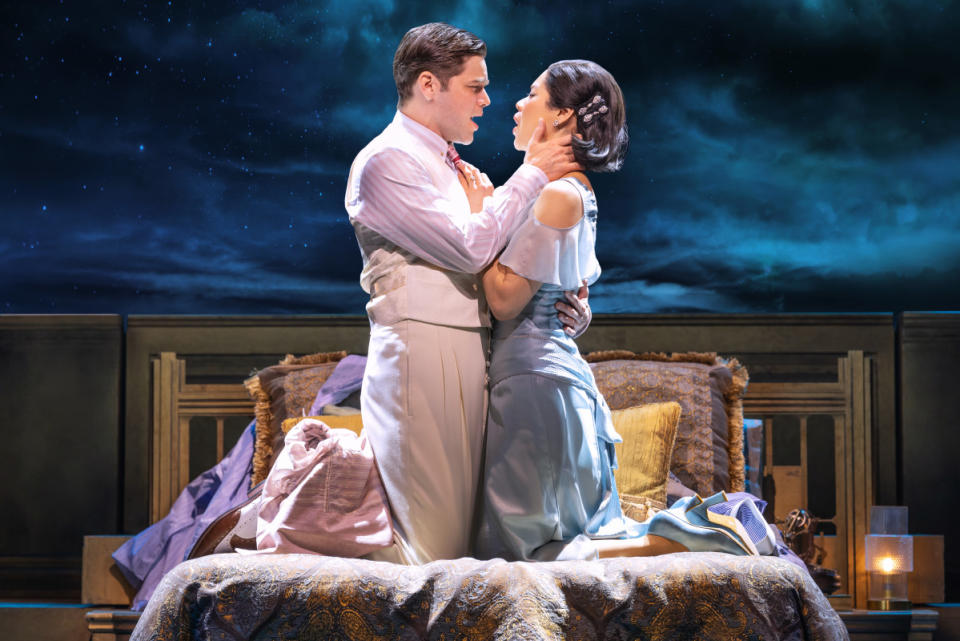
Photo: Matthew Murphy and Evan Zimmerman/Courtesy of The Great Gatsby
While the production's narrative stays true to the story fans have come to love, an eagle-eyed audience member may spot a few inaccuracies when it comes to its time period, particularly in the show's costumes.
"In my initial conversation with our director, he said, 'Let's do a period Gatsby, but the Gatsby of people's imaginations,'" says Linda Cho, costume designer on the production. "The expected silhouette from the 1920s is a drop-waist, sort of loose-around-the-waist look, which certainly makes dancing tricky — you need costumes that hug the body because, if you have loose fabric around your waist, a person wouldn't be able to lift you, for instance. For men, too, they don't normally have their arms waving in the air dancing in a suit jacket, so everything has to be built with gussets. I have to balance those needs with the clothing."
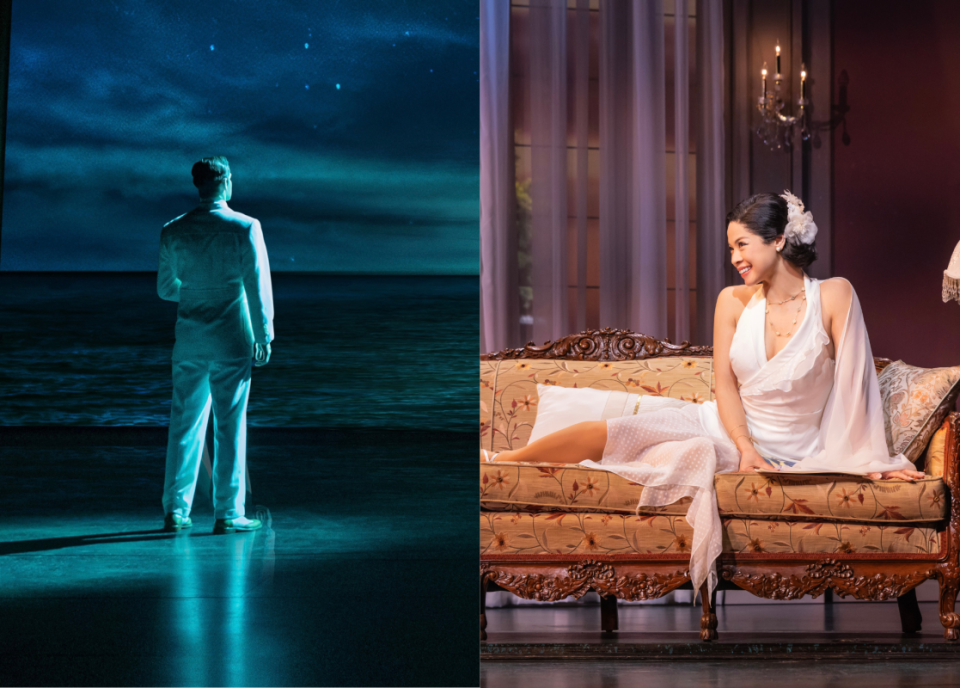
Photo: Matthew Murphy and Evan Zimmerman/Courtesy of The Great Gatsby
The costumes in Broadway's "The Great Gatsby" don't ever distract from each character's storytelling. In fact, they connect them to one another, specifically through the color palettes. At the start of the show, Jay Gatsby (played by Jeremy Jordan) makes a brief appearance in a white suit, painting a picture of an illustrious and mysterious figure, leaving the audience itching to better understand the man behind the mystifying silhouette. A few moments later, we meet Daisy Buchanan (played by Eva Noblezada), basking in her East Egg home wearing an equally alluring all-white ensemble.
"Immediately, it gives, 'We are summer, we are privileged, we are 1920s,'" Cho says. "I wanted them to own the space and show that they're connected to that world [and each other]."
This visual link simultaneously reminds audience members of their ill-fated romance and introduces those unfamiliar with the story to a seemingly bright and shining relationship.
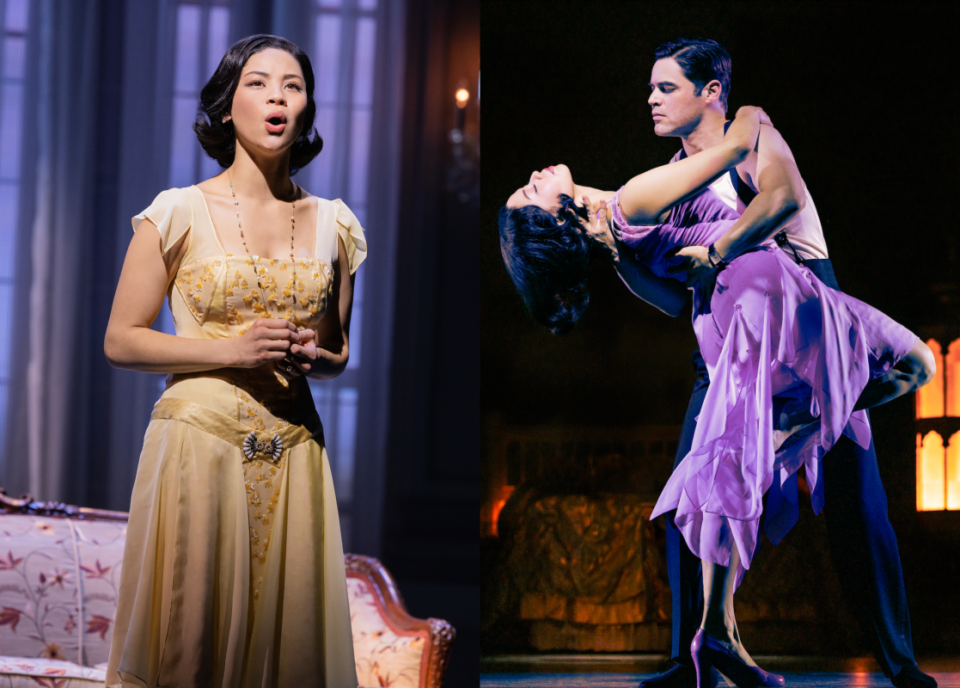
Photos: Matthew Murphy and Evan Zimmerman/Courtesy of The Great Gatsby
A light, pastel color palette persists in Daisy's wardrobe throughout the show, with the exception of one very glamorous, rose gold gown in the play's final party scene. "She's trapped in this hothouse — she's a flower trapped within her circumstances, and she can't survive outside of them," says Cho. "She's a woman trapped by her wealth in many ways."
Daisy's flowing, chiffon-heavy wardrobe also helps to distinguish her from the in-your-face glamour of the ensemble cast, who are established in quintessential black-and-gold 1920s flapper dresses to convey the opulence of the "old money" crowd. From then on, the lavishness of their costumes only increases, transforming into a distinctive "new money" look filled with peacock colors and jewel tones. "I wanted everything to be visually distinctive and I wanted to keep raising the stakes from the black and gold," Cho says.
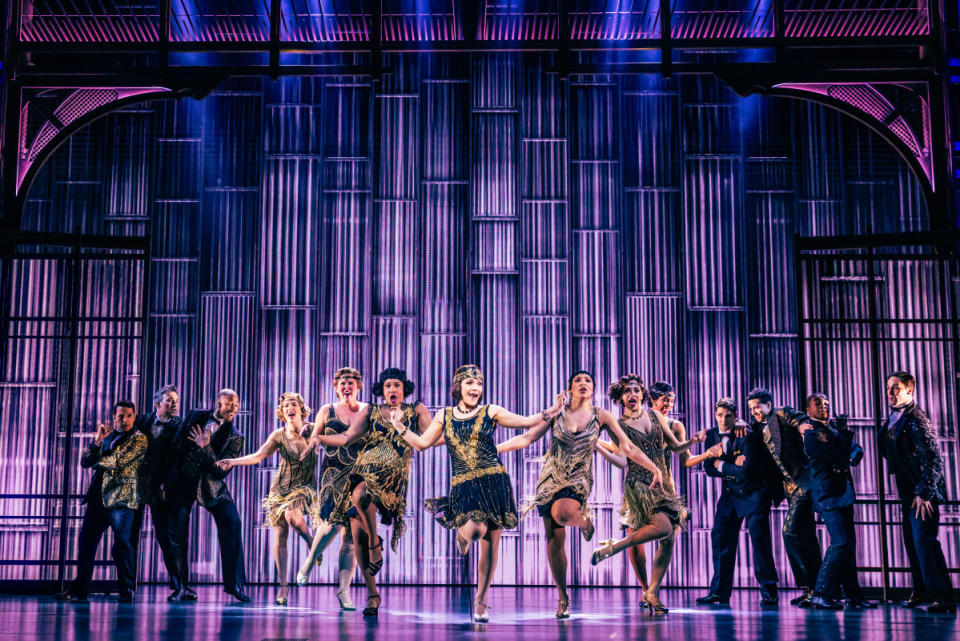
Photo: Matthew Murphy and Evan Zimmerman/Courtesy of The Great Gatsby
The bright colors help construct the grand world of "Gatsby," but Cho felt the costumes needed more impact, even if it meant they were only worn for a few seconds. "I knew we needed height, length and drama, but we couldn't have giant headdresses or big trains given the choreography," she explains. "So, I talked to the director and proposed a costume parade: a giant entrance where people come in, show their costume, run off stage, take off what they can't dance in and come back."
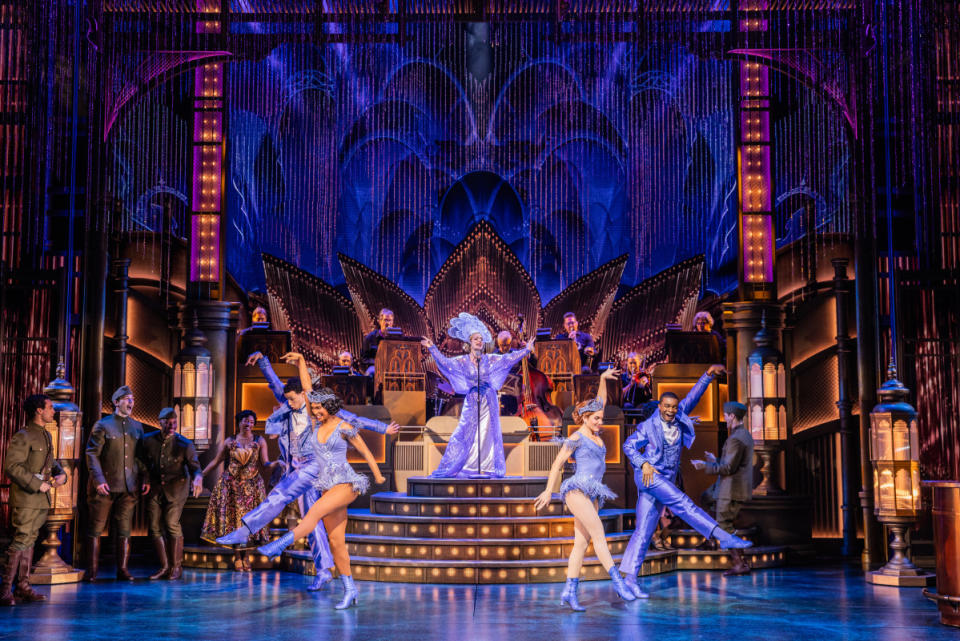
Photo: Matthew Murphy and Evan Zimmerman/Courtesy of The Great Gatsby
The ensemble's costume parade takes place during one of Gatsby's over-the-top parties where he flaunts his "new money" wealth in every way possible. This desperation to prove himself (and his worth) to Daisy — a woman already married into generational wealth — is seen well beyond these fêtes: For example, when Gatsby and Daisy are about to reconnect for the first time in the show, we see the male lead go through racks of suit jackets before finally landing on a pink option (a nod to the book) brought out by dozens of butlers in Gatsby-branded uniforms.
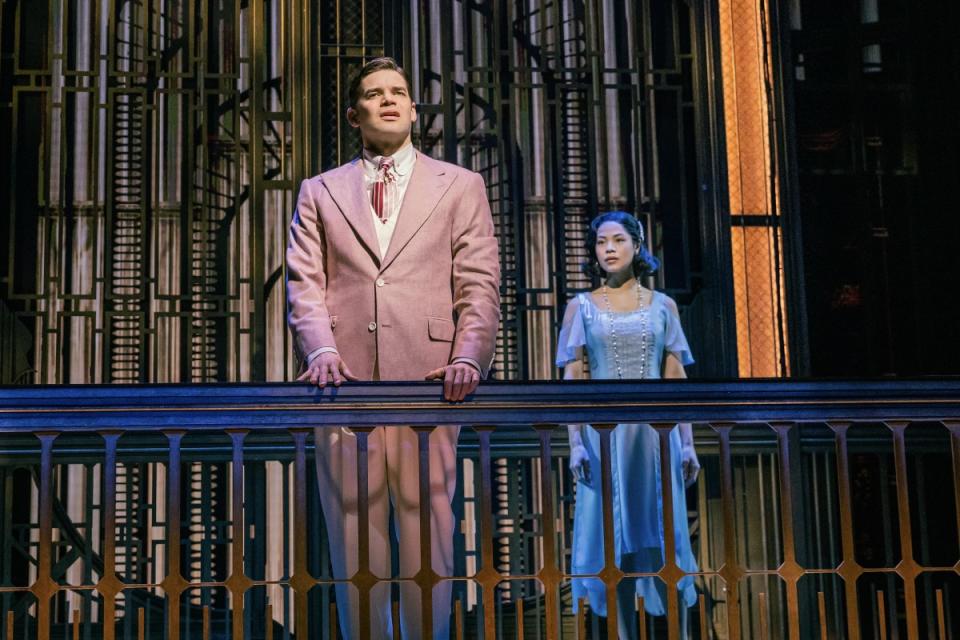
Photo: Matthew Murphy and Evan Zimmerman/Courtesy of The Great Gatsby
"If you're brought up in a household with a legacy of servants, their uniforms likely haven't changed from your grandparents' time. There's that lived experience, versus somebody like Gatsby who has a studied experience of living with wealth, not a lived one," Cho explains. "I wanted his [butlers] to look like they work at a five-star hotel. Everything has a newness to it.”
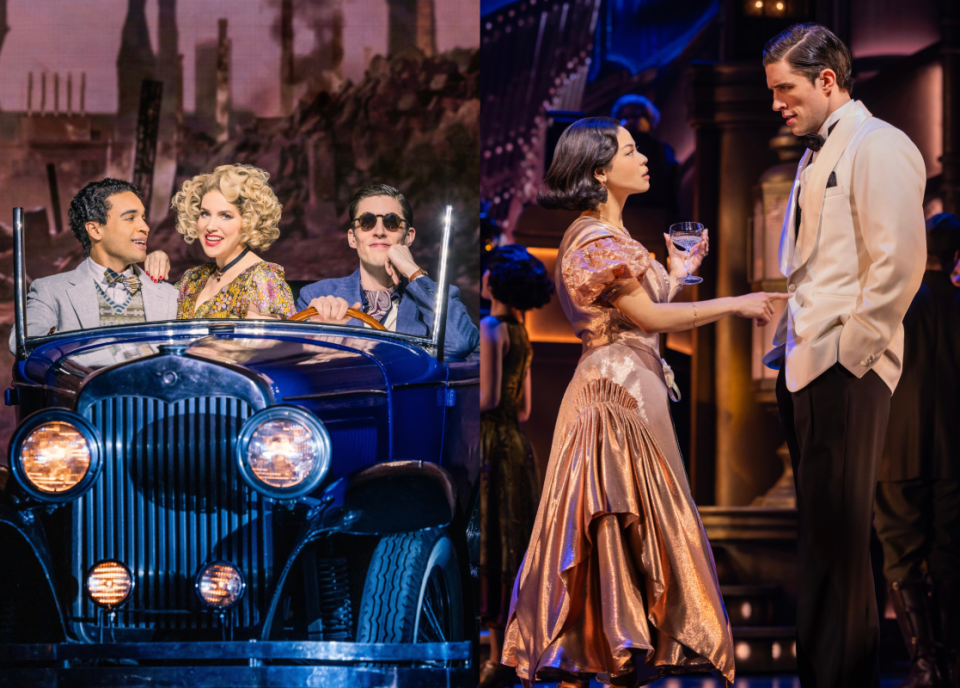
Photos: Matthew Murphy and Evan Zimmerman/Courtesy of The Great Gatsby
In contrast to Gatsby's somewhat more garish style, Daisy's husband Tom represents the "old money" aesthetic in a uniform of a solid blazer, white button-up and high-waisted trousers. It whispers "expensive" (versus Gatsby's eye-catching outfits, which yell it). "Tom is more classic, whereas Gatsby is more fashion-forward," per Cho.
Though Tom's appearance may lean into a quiet luxury theme, those he spends his free time with are quite the opposite. His mistress Myrtle is on the lower end of the social class, as demonstrated by her vivid, vibrant and often chaotically-patterned outfits.
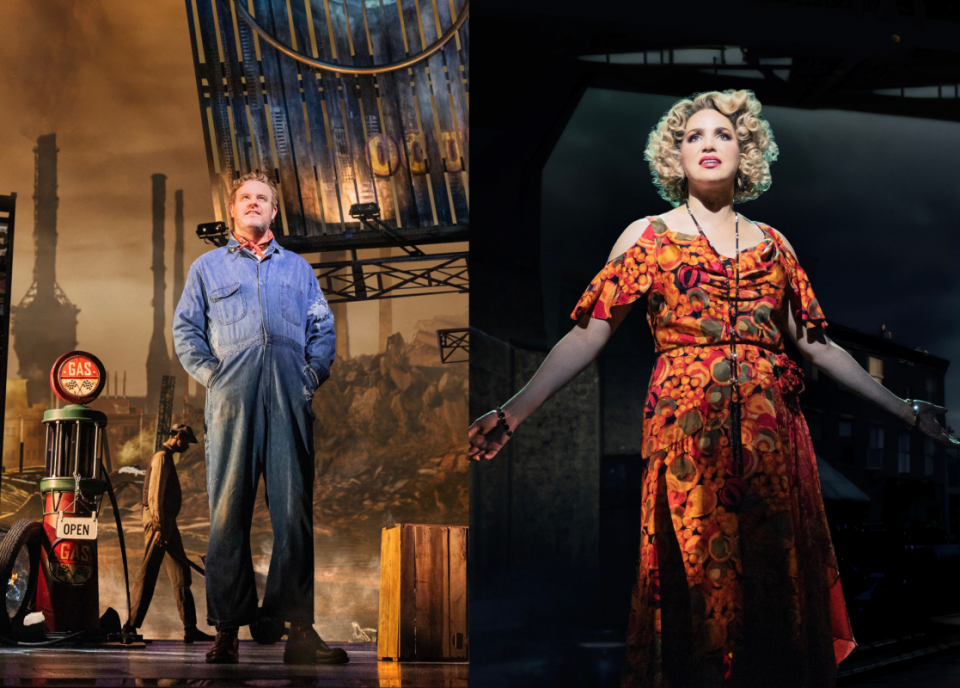
Photos: Matthew Murphy and Evan Zimmerman/Courtesy of The Great Gatsby
"Her first dress is a small, yellow-y, brown-y pattern that looks dirty and almost like piles of garbage and car parts," says Cho. "She's just the ultimate aspirational person who's reaching but doesn't quite get there."
To authentically capture Myrtle and her husband George Wilson's working-class wardrobe, Cho sourced a significant amount of their costumes from vintage shops — a styling tactic that makes sense for these characters, specifically.
"The problem with vintage is it doesn’t hold up very well. A lot of the silks, especially, dry rot, so they'll just fall apart in your hands, and these clothes have to last for eight shows a week,” she explains. "But for the Wilsons, it's okay if they fall apart a bit, because they're supposed to be poor, Valley of the Ashes people."
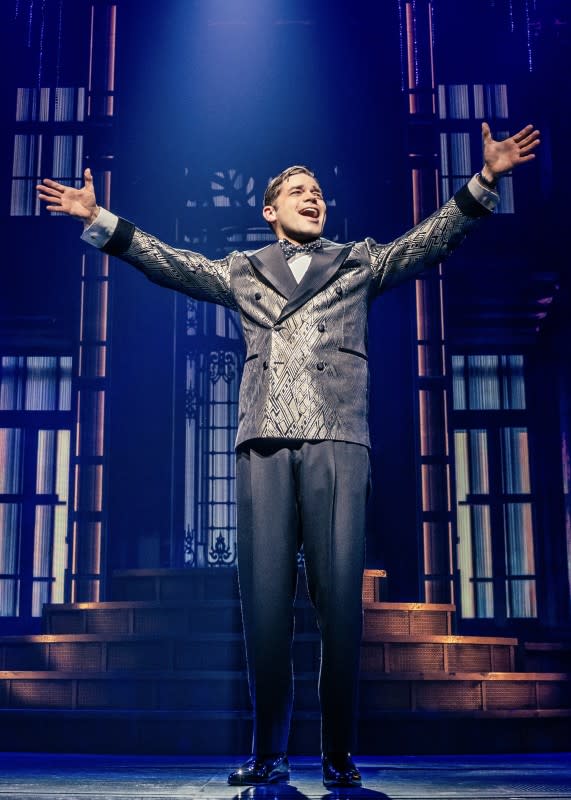
Photo: Matthew Murphy and Evan Zimmerman/Courtesy of The Great Gatsby
This also further emphasizes just how major the divide is between the characters: While the Wilsons' clothing is a bit tattered and messy, Gatsby is wearing custom suits cut from art-deco, metallic black brocade fabrics that catch every light in the theater — a look that actor Jordan advocated for himself.
"When Jeremy came to the fitting, he loved the brocade jacket," recounts Cho. "Originally, he was going to perform his big 11 o'clock hour song in the following scene's outfit, but instead we made it a costume change. He said, 'I want to do this number in this jacket.'"
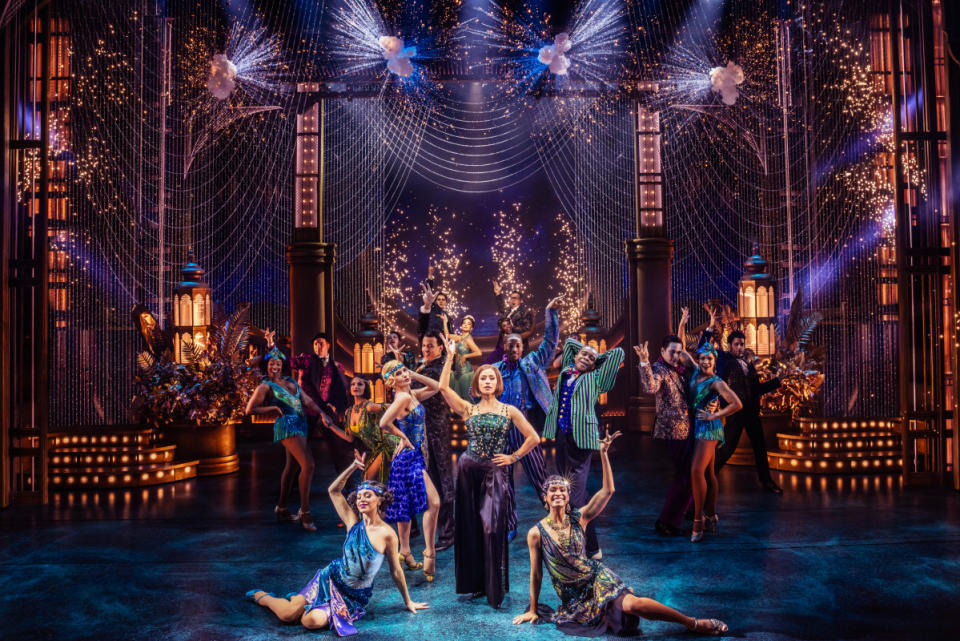
Photo: Matthew Murphy and Evan Zimmerman/Courtesy of The Great Gatsby
The period inaccuracies in the costumes, though, are perhaps best exemplified by Jordan, Daisy's close friend and a female golfer. She wears a very singular uniform of high-waisted, wide-leg pants and a statement, tucked-in blouse throughout each scene — an outfit that at first glance reads more current. "I looked at a lot of Audrey Hepburn and references of women in various athletic pursuits," Cho says.
Despite the women on her mood board, Cho ultimately had to mostly forego any 1920s-specific dressing for Jordan: "To make the clothes more appealing to a modern eye, you have to sometimes cheat. So she has a more snatched waist and a better general fit in her trousers. We want things to be flattering so that the audience understands that these people are the beauty standards of their period, but through our own vocabulary."
At the end of the day, Cho's number-one priority when costume designing a show is ensuring the confidence and comfort of her cast. "They have to wear it eight times a week," she says. "It's all about the storytelling and the big picture. So you might lose a battle with one costume, but in the end, you ultimately win the war overall when your cast feels beautiful."
"The Great Gatsby" opens at The Broadway Theater in New York City on Thursday, April 25.
Never miss the latest fashion industry news. Sign up for the Fashionista daily newsletter.

